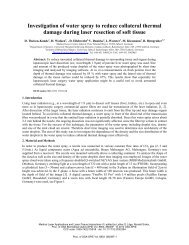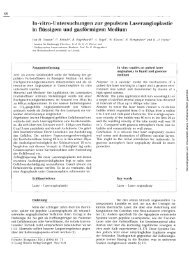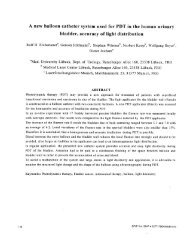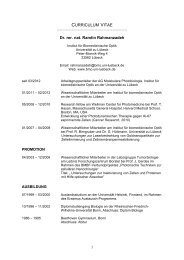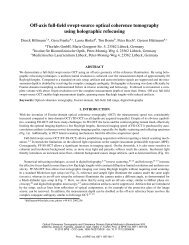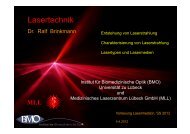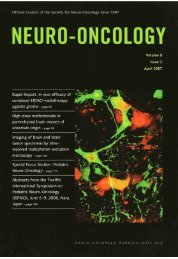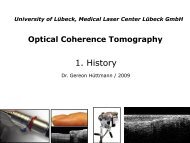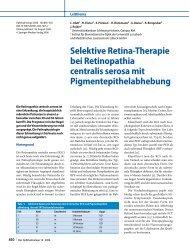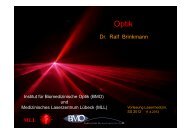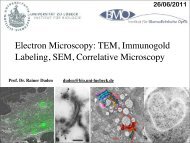Invited p aper Mechanisms of femtosecond laser nanosurgery of ...
Invited p aper Mechanisms of femtosecond laser nanosurgery of ...
Invited p aper Mechanisms of femtosecond laser nanosurgery of ...
You also want an ePaper? Increase the reach of your titles
YUMPU automatically turns print PDFs into web optimized ePapers that Google loves.
VOGEL et al. <strong>Mechanisms</strong> <strong>of</strong> <strong>femtosecond</strong> <strong>laser</strong> <strong>nanosurgery</strong> <strong>of</strong> cells and tissues 1027cumulative chemical damage may arise from the free electrons.By contrast, when locally confined irradiation is used toachieve knockout <strong>of</strong> individual cell organelles or intracellulardissection, the irradiance threshold for cell death is considerablyhigher. The role <strong>of</strong> plasma-mediated chemical effects forthese procedures will be discussed in Sect. 7.1, in comparisonto the possible role <strong>of</strong> thermal and thermomechanical effects.Recently, non-resonant ultra-fast processes <strong>of</strong> bond breakinginduced by the large field strength in <strong>femtosecond</strong> <strong>laser</strong>pulses have been discussed in the context <strong>of</strong> <strong>laser</strong> ablation[151, 152]. However, these processes occur at surfaceswhere hot electrons can be emitted from the target, thus creatinga large field among the remaining ions that can causea Coulomb explosion, and where material decomposed bya strong <strong>laser</strong> field can freely expand. They are not likelyto play a role in the bulk <strong>of</strong> transparent media, especiallyin the low-density plasma regime, i.e. at comparatively lowfield strengths. Here, chemical changes are rather generatedthrough resonant interactions between quasi-free electronsand molecules.5 Temperature evolution during pulse series5.1 Calculation <strong>of</strong> temperature distributionThe deposition <strong>of</strong> <strong>laser</strong> energy into the mediumis mediated by the generation and subsequent acceleration<strong>of</strong> free electrons. The energy carried by the free electronsis transferred to the heavy particles in the interaction volumethrough collisions and non-radiative recombination processesresulting in a heating <strong>of</strong> the atomic, molecular, andionic plasma constituents. To assess the time needed to establishan equilibrium temperature, we need to look at thecharacteristic time for electron cooling (the transfer <strong>of</strong> kineticelectron energy during collisions) and at the time scale forrecombination, which in water progresses through hydration<strong>of</strong> the free electrons. The time constant for electron coolingis <strong>of</strong> the order <strong>of</strong> only a few picoseconds [143, 153], and thetime constant for hydration <strong>of</strong> free electrons in water is evenshorter, about 300 fs [103]. However, the hydrated states possessa relatively long lifetime <strong>of</strong> up to 300 ns [103]. In theframework <strong>of</strong> our model, the different steps are treated as onerecombination process according to (11). As the frequency<strong>of</strong> recombination events is proportional to ϱ 2 c , the recombinationtime depends on the free-electron density. It takes about40 ps until the free-electron density decreases by one order <strong>of</strong>magnitude from a peak value <strong>of</strong> ϱ c = 10 20 cm −3 , and about20 ps for a peak value <strong>of</strong> ϱ c = 10 21 cm −3 [81, 91]. For lowdensityplasmas it will thus take between a few picosecondsand tens <strong>of</strong> picoseconds until a ‘thermodynamic’ temperatureis established [143].The temperature rise can be determined by calculating thevolumetric energy density gained by the plasma during the<strong>laser</strong> pulse. This calculation is particularly easy for <strong>femtosecond</strong>pulses because the pulse duration is considerably shorterthan the electron cooling and recombination times. Therefore,hardly any energy is transferred during the <strong>laser</strong> pulse, and theenergy density deposited into the interaction volume is simplygiven by the total number density ϱ max <strong>of</strong> the free electronsproduced during the pulse multiplied by the mean energy gain<strong>of</strong> each electron. The mean energy gain <strong>of</strong> an electron is givenby the sum <strong>of</strong> ionization potential ˜∆ and average kinetic energy,the latter being (5/4) ˜∆ for free electrons produced bycascade ionization (Sect. 2.2). This yields the following simplerelation for the plasma energy density ε at the end <strong>of</strong> the<strong>laser</strong> pulse:ε = ϱ max (9/4) ˜∆. (18)Note that this simple equation neglects the collisional energytransfer before impact ionization that is included in (8) andconsidered in more detail by more advanced models basedon the use <strong>of</strong> complete collision integrals [21, 113]. This maylead to an underestimation <strong>of</strong> the rise in energy density correspondingto one free electron. On the other hand, (18) treatsfree electrons produced by multiphoton ionization in the sameway as those produced by impact ionization even though theystart with zero kinetic energy <strong>of</strong> electron and hole, which willrather overestimate the energy density increase. From (18),the temperature rise in the interaction volume after a single<strong>laser</strong> pulse can then be calculated by ∆T = ε/(ϱ 0 C p ),where C p is the heat capacity and ϱ 0 the mass density <strong>of</strong> themedium.The evolution <strong>of</strong> the temperature distribution within andaround the interaction volume after a single 100-fs pulse(λ = 800 nm), during application <strong>of</strong> series <strong>of</strong> 100-fs pulsesemitted at various repetition rates, and during cw <strong>laser</strong> irradiation(λ = 514 nm), was calculated by solving the differentialequation for heat diffusion with the appropriate Green’sfunctionT(x, y, z, t) =∑N−1n=0∫min(t−n/ f,τ L )0∫A∫∞−∞∫{ ( x ′2 + y ′2 ) }exp −2a 2 − 2 z′2b 21×8πϱ 0 C p κ(t − n/ f − t ′ ){ (x − x ′ ) 2 + (y − y ′ ) 2 + (z − z ′ ) 2 }× exp4κ(t − t ′ dx ′ dy ′ dz ′ dt ′ .)(19)Here A is the peak density <strong>of</strong> absorbed power in the irradiatedvolume, f is the puls repetition rate, κ is the thermaldiffusivity, a and b are the short and long half-axes <strong>of</strong> the freeelectron-densitydistribution described by (17) (1/e 2 values<strong>of</strong> electron density), N = Int(tf) + 1 is the number <strong>of</strong> pulseswhich were absorbed until time t, andτ L is the <strong>laser</strong> pulsewidth. The integrals over x ′ , y ′ ,andz ′ were solved analyticallyusing Mathematica s<strong>of</strong>tware, whereas the integrationover t ′ was done numerically. We assumed the temporal shape<strong>of</strong> the <strong>laser</strong> pulses to be rectangular. We used the valuesϱ = 1000 kg m −3 for the density, C p = 4187 J K −1 kg −1 forthe heat capacity, and κ = 1.38 × 10 −7 m 2 s −1 for the heat diffusivity<strong>of</strong> water [154].5.2 Evolution <strong>of</strong> the temperature distributionThe spatial temperature distribution at the end <strong>of</strong>a single fs <strong>laser</strong> pulse, before heat diffusion sets in, reproducesthe shape <strong>of</strong> the free-electron distribution <strong>of</strong> Fig. 8. Hence, the



